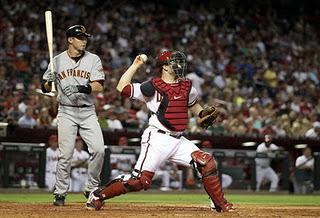When an airplane takes off from a runway, it doesn’t just shoot straight up into the sky. It stays low to the ground and gradually increases its altitude. A catcher coming out of the crouch should react the same way. A good fielder catching a ground ball and throwing to first will look like that as well. A base runner getting a jump to steal second or third should look like that too.The mechanics of taking off like an airplane are as follows:

- Like the airplane’s landing gear, a players feet should always be directly under his hips and shoulders. Some catchers will shift off to the side with their feet after receiving the pitch instead of keeping them underneath them as they move forward to throw. This creates an imbalance and a lack of power because of the catcher’s poor base. It is the same for an infielder. Throughout the fielding and throwing process, the feet should be squarely underneath the body. Of course, if a fielder makes a great play by reaching for a ball or diving, their feet certainly will not be directly underneath them. However, part of what separates the good fielder from the so-so one is the ability to get their feet underneath them more quickly after catching or diving for the ball in order to make the throw.

- As described, an airplane gradually increases in altitude as it takes off. Catchers, fielders, and base runners should do this also. If any of those players stand up tall too quickly, they will lose their power and quickness. A phrase I use a lot is “start small and finish tall.” By that I mean a catcher should stay low and think of keeping his hips under the ball as long as possible so that he can stay low and gradually come up to catch and throw. Only after following through should he be at his tallest. The same thing applies to an fielder fielding a ground ball. A base runner looking to get a great jump on a steal should not stand up immediately when he turns to run either. If he does, the upward motion will slow him down. He should think “quick and low” with his jump and, like the airplane, come up gradually.
In baseball, standing tall when you are in the act of doing something usually does not have much value. Staying lower generally allows for more quickness, power, and balance.

